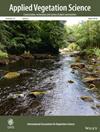Effects of long-term mowing on species diversity, biomass and composition of plant community in a semi-arid grassland in northeastern China
Abstract
Questions
How does long-term, moderate-intensity mowing affect plant community diversity, biomass, and composition in semi-arid grasslands? And what are the underlying mechanisms that drive differences in plant community structure and functions between mowed and unmowed grasslands?
Location
A semi-arid grassland in Jilin Province, northeastern China.
Methods
In a 30-year experiment, we investigated long-term effects of mowing on the grassland ecosystem in northeastern China by comparing plant community diversity, biomass, and composition between mowed and unmowed permanent plots across six grasslands.
Results
Long-term mowing did not affect plant species richness, but increased species evenness by 29%. Mowing had little effects on above-ground (shoot) and below-ground (root) biomass. The unchanged above-ground biomass in the mowed areas was attributed to a trade-off between biomass of grasses and forbs: mowing significantly increased forb biomass by 50%, but reduced grass biomass by 20% and the grass to forb biomass ratio by 46%. Mowing also reduced biomass of the dominant Leymus chinensis grass by 24% and litter biomass by 56%. Regression analyses indicated that the species evenness was negatively affected by L. chinensis biomass and litter biomass.
Conclusions
This study demonstrates that, although long-term moderate mowing has limited effects on plant species richness and plant biomass, such a managed strategy can greatly reduce the dominance of grass species and allow the growth of forb species, leading to a higher species evenness in the plant community. This win–win situation promotes forage production for farmers while increasing plant diversity for conservation, suggesting that current mowing tactics can be a sustainable management practice in this ecosystem. However, the continuous loss of plant litter because of mowing may have negative influences on soil nutrient availability in the long run. From this perspective, a short-term halt in mowing or fertilization that allows plants and soil nutrients to recover could represent a more optimal protocol for management.

 求助内容:
求助内容: 应助结果提醒方式:
应助结果提醒方式:


